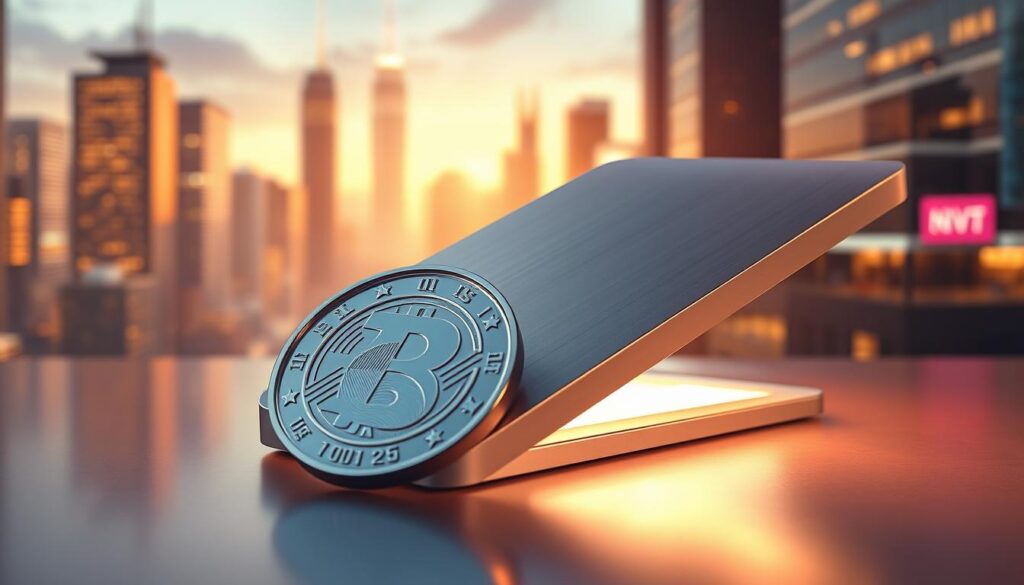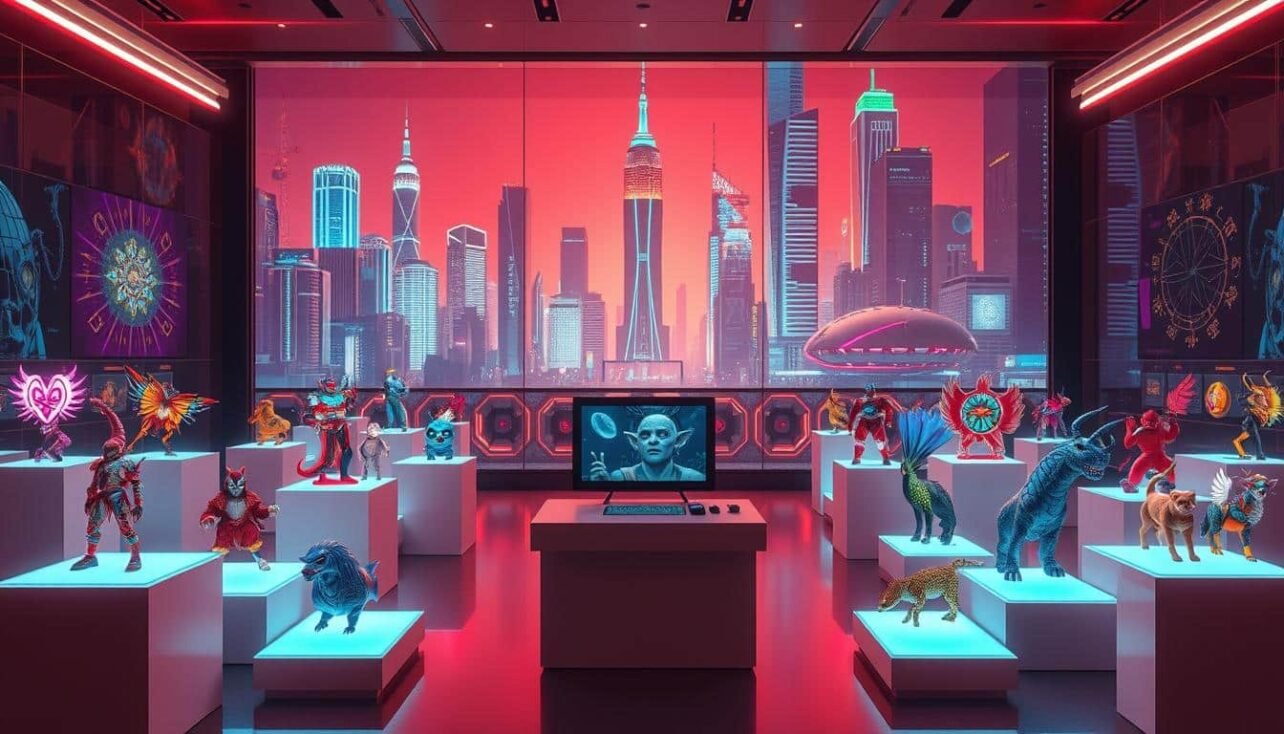Non-fungible tokens have transformed creative expression into verifiable digital ownership. These blockchain-based assets enable artists to authenticate their work while giving collectors exclusive rights to unique pieces. From Mike Winkelmann’s record-breaking $69 million sale to experimental projects blending sound and visuals, this space redefines what art means in the modern era.
The marketplace for digital art thrives on innovation and accessibility. Platforms like OpenSea and Foundation allow creators to bypass traditional gatekeepers, connecting directly with global audiences. However, success requires more than talent – understanding crypto wallets, gas fees, and smart contracts separates casual attempts from professional ventures.
Key Takeaways
- NFTs represent unique digital assets with blockchain-verified ownership
- Basic blockchain knowledge and crypto wallets are essential starting points
- Successful projects combine artistic vision with technical execution
- Pricing strategies balance market trends and collector psychology
- Global reach requires tailored marketing across social platforms
- Long-term success blends creative skills with business fundamentals
Understanding NFTs and Blockchain Technology
Unique digital assets emerge as NFTs revolutionize ownership verification. These tokens transform how we perceive authenticity in the digital space, offering creators and collectors unprecedented control over their work.
What Makes NFTs Irreplaceable?
Each token carries a distinct identification code stored on a decentralized ledger. Unlike cryptocurrencies, these assets can’t be swapped for identical items. This uniqueness creates scarcity, turning digital files into collectible treasures.
Blockchain’s Role in Secure Transactions
The underlying blockchain technology acts as an unchangeable record keeper. Every ownership transfer gets permanently logged, building trust through transparency. Three key features ensure security:
- Decentralized networks prevent single-point data manipulation
- Smart contracts automate royalty payments for creators
- Encrypted transaction history deters counterfeiting
This system empowers artists by turning fleeting digital creations into lasting, trackable assets. Collectors gain verified proof of authenticity while participating in a global marketplace free from traditional barriers.
Exploring Profitable NFT Art Ventures
The digital collectibles space continues evolving, with iconic non-fungible tokens like Pak’s $91.8 million “Merge” redefining artistic value. This market thrives on innovation, where pixelated avatars and algorithm-generated masterpieces command seven-figure sums. Established artists and newcomers alike find audiences hungry for original concepts.

Identifying Trends and Market Opportunities
Collections like Bored Ape Yacht Club demonstrate how artistic vision paired with community perks drives demand. Current trending formats include:
- Generative pieces using code-based creation methods
- Interactive multimedia experiences
- Limited-edition photography series
Seasoned painters transitioning to digital formats often attract existing followings. Emerging talents build cult-like communities through consistent storytelling. Savvy artists analyze buyer psychology, emphasizing exclusivity and cultural relevance.
Successful ventures balance aesthetic appeal with strategic utility. Collectors increasingly seek assets offering social capital or event access alongside visual impact. Projects with sequential narratives or unlockable content tend to maintain long-term value better than standalone pieces.
How to Create and Sell NFT Art Collection
Transforming digital files into blockchain-certified assets requires methodical preparation. Begin with high-resolution files in formats like PNG or MP4 that reflect your signature style. Originality remains paramount – conduct reverse image searches to confirm uniqueness before proceeding.

Legal clearance forms the foundation of trustworthy collections. Verify ownership of all visual elements, especially when incorporating third-party assets. This due diligence prevents disputes and builds collector confidence in your artwork authenticity.
The technical workflow involves three critical decisions:
- Blockchain network selection (Ethereum remains popular for digital art ventures)
- Wallet compatibility with chosen marketplace
- Minting options (lazy vs. traditional)
Minting embeds permanent identifiers into your file through smart contracts. This process converts creative output into tradeable tokens while recording provenance. Effective metadata descriptions boost discoverability – think of titles and attributes as search engine bait.
Successful collections blend aesthetic appeal with strategic positioning. Analyze trending themes without sacrificing originality. Pair visually striking pieces with behind-the-scenes narratives that resonate emotionally. This combination transforms casual viewers into invested collectors.
Technical execution demands attention to gas fees and contract terms. Schedule minting during low-network congestion periods to optimize costs. Test transactions with small files before launching full collections to avoid costly errors.
Setting Up a Crypto Wallet for NFT Transactions
Digital asset management begins with choosing secure storage solutions. Crypto wallets act as gateways to blockchain networks, enabling ownership verification and peer-to-peer exchanges. These tools store private keys while facilitating interactions with decentralized platforms.

Selecting the Right Wallet for Your Needs
Browser-based options like MetaMask dominate Ethereum-based transactions due to marketplace compatibility. Hardware alternatives such as Ledger Nano X prioritize offline key storage for heightened protection. Consider these factors when evaluating options:
| Wallet Type | Security Level | Best For | Supported Networks |
|---|---|---|---|
| MetaMask | Medium | Frequent traders | Ethereum, Polygon |
| Ledger Nano X | High | Long-term storage | Multi-chain |
| Coinbase Wallet | Medium | Beginners | Ethereum, Solana |
| Trust Wallet | Medium | Mobile users | Binance Chain, Ethereum |
Transaction fees impact profitability across blockchain networks. Ethereum-based operations typically cost more than Polygon transactions. Maintain sufficient crypto reserves to cover gas fees during peak activity periods.
Security protocols separate professional practices from amateur attempts. Write down recovery phrases on physical paper rather than digital files. Enable two-factor authentication and regularly update wallet software.
Choosing the Ideal NFT Marketplace
Selecting the perfect platform shapes your collection’s visibility and profitability. Blockchain compatibility acts as the first filter – your minting network determines which marketplaces can host your work. Popular options range from generalist hubs to niche-focused communities.

Comparing Platform Features and Fees
OpenSea dominates with multi-chain support and 2.5% transaction fees. Rarible counters with customizable storefronts and community-driven governance. Consider these elements:
- Fee structures impacting profit margins
- Built-in promotional tools
- Secondary sales royalty options
SuperRare’s curated approach contrasts sharply with open platforms. Its selective vetting process attracts high-end collectors but limits accessibility for new creators.
Aligning Marketplaces with Your Art Style
Abstract digital paintings thrive on platforms emphasizing visual artistry. Photography collections gain traction on specialized platforms with targeted audiences. Choosing the right NFT marketplace involves matching your aesthetic to platform demographics.
Gaming assets perform best on Web3-focused exchanges. Generative art finds engaged communities on tech-forward platforms. Analyze competitor success stories within your niche before committing.
Minting Your NFT: Process and Best Practices
Converting digital creations into blockchain-certified assets demands technical precision and market awareness. This phase turns files into tradeable tokens while establishing verifiable ownership through decentralized networks.
Step-by-Step Guide to Minting Digital Art
Begin by preparing high-quality files and verifying originality. Most platforms follow this workflow:
- Upload artwork with optimized dimensions (under 100MB recommended)
- Add metadata: titles, traits, and narrative context increase perceived value
- Select blockchain network based on target audience and fee tolerance
Platforms like OpenSea simplify this process through drag-and-drop interfaces. Always preview metadata displays before finalizing entries.
Managing Gas Fees and Smart Contracts
Transaction costs vary dramatically across networks. Ethereum’s gas fees often spike during high-demand periods. Consider these strategies:
| Minting Type | Cost Timing | Risk Level | Best For |
|---|---|---|---|
| Lazy Minting | Paid by buyer | Low | New creators |
| Traditional | Upfront payment | Medium | Established artists |
| Scheduled | Off-peak hours | High | Cost optimizers |
Smart contracts govern royalty percentages and ownership transfers. Test these agreements using blockchain explorers before public releases. Networks like Polygon offer lower fees for creators prioritizing affordability over Ethereum’s liquidity.
Pricing Your NFT Artwork for Maximum Value
Determining the optimal value for digital collectibles combines market analysis with psychological insight. Strategic pricing decisions directly influence buyer engagement and perceived worth in competitive marketplaces.
Fixed Price vs. Auction Strategies
Fixed pricing offers stability for emerging creators. Immediate purchase options attract collectors seeking instant ownership without bidding wars. This method works well for standardized editions or artists building initial credibility.
Auction formats thrive on scarcity and competition. Limited-time sales with reserve prices create urgency, often driving bids beyond baseline valuations. Rare 1/1 pieces particularly benefit from this approach.
| Strategy | Pricing Control | Buyer Engagement | Revenue Predictability |
|---|---|---|---|
| Fixed Price | Full | Low | High |
| Timed Auction | Minimum Reserve | High | Variable |
| Dutch Auction | Descending | Moderate | Guaranteed |
Research comparable sales using blockchain explorers like Etherscan. Analyze traits like edition size, artist reputation, and unlockable content. Rarity metrics should inform starting bids or fixed rates.
Psychological pricing tactics increase conversion rates. Ending prices with .99 instead of round numbers can boost perceived affordability. For high-value pieces, whole numbers convey premium status.
Marketing Strategies to Boost Your Digital Art Sales
Effective promotion separates overlooked digital pieces from sought-after blockchain assets. While technical execution establishes credibility, strategic outreach transforms creators into recognizable names within decentralized communities.
Leveraging Social Media and Influencers
Platforms like Twitter Spaces and Instagram Reels offer direct access to crypto-savvy audiences. Artists gain traction by showcasing works-in-progress through time-lapse videos or hosting live minting sessions. Partnering with mid-tier crypto influencers often yields better ROI than celebrity endorsements – their engaged followers convert faster.
A viral TikTok challenge featuring your digital art style can spark organic growth. One generative artist boosted sales 300% by collaborating with a collector on a hashtag giveaway campaign.
Building Your Brand in the NFT Community
Consistent visual identity across marketplaces and social profiles builds recognition. Active participation in Discord groups establishes authority – share minting tips while subtly showcasing your latest work.
Collaborative drops with established creators introduce your portfolio to new collectors. Attend virtual gallery openings to network organically. Projects blending limited-time releases with unlockable content often see repeat buyers.
Authenticity drives long-term success. Document your creative process transparently – collectors value stories behind the art. As communities reward genuine engagement over hard sells, balance promotion with relationship-building.


No comments yet